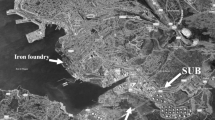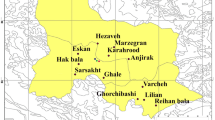Abstract
The aim of this study was to evaluate element (sodium, magnesium, potassium, calcium, chromium, manganese, iron, cobalt, nickel, copper, zinc, arsenic, cadmium, and lead) deposition in honey bees (Apis mellifera L.) (worker bees, drone bees, and bee broods) and their products (wax and multifloral honey) in the central and north parts of Serbia using inductively coupled plasma mass spectrometry (ICP-MS). The study was carried out during the spring and summer seasons when the honeybees were active (2019). Fifty-four colonies of honey bees from different apiaries (located in Rudnik, Lazarevac, and Ležimir) were used in this study. Significant differences in element concentrations were found among locations (P < 0.05). The highest deposition of elements (sodium, calcium, manganese, iron, cobalt, nickel, zinc, arsenic, and cadmium) was found in worker bees. The most commonly detected elements in wax were chromium and lead. Mg had a significant (P < 0.01) correlation with K, Fe, Cu, and As. This study shows that honey bees (worker bees, drone bees, and bee broods) could be more useful as bioindicators of environmental element deposition (toxic and non-toxic) than multifloral honey. Also, this study shows that Serbian multifloral honey meets safety criteria concerning the concentrations of toxic elements.







Similar content being viewed by others
References
CEC Thematic Strategy for Soil Protection. COM (2006) 231 Final Commission of the European Communities, Brussels (2006) (22.9.2006)
Peralta-Videa JR, Lopez ML, Narayan M, Saupe G, Gardea-Torresdey J (2009) The biochemistry of environmental heavy metal uptake by plants: implications for the food chain. Int J Biochem Cell Biol 41(8–9):1665–1677. https://doi.org/10.1016/j.biocel.2009.03.005
Saracoglu S, Tuzen M, Mendil D, Soylak M, Elci L, Dogan M (2004) Heavy metal content of hard biscuits produced in Turkey. Bull Environ Contam Toxicol 73:264–269. https://doi.org/10.1007/s00128-004-0422-0
Sari A, Mendil D, Tuzen M, Soylak M (2008) Biosorption of cd(II) and Cr(III) from aqueous solution by moss (Hylocomium splendens) biomass: equilibrium, kinetic and thermodynamic studies. Chem Eng J 144:1–9. https://doi.org/10.1016/j.cej.2007.12.020
Sodre GD, Marchini LC, Zucchi O, Nascimento VF, Otsuk IP, Moreti A (2007) Determination of chemical elements in Africanized Apis mellifera (Hymenoptera: Apidae) honey samples from the state of Piaui, Brazil. Quim Nova 30:920–924
Uluozlu OD, Tuzen M, Mendil D, Soylak M (2007) Trace metal content in nine species of fish from the black and Aegean seas, Turkey. Food Chem 104:835–840. https://doi.org/10.1016/j.foodchem.2007.01.003
Jarup L (2003) Hazards of heavy metal contamination. Br Med Bull 68:167–182. https://doi.org/10.1093/bmb/ldg032
Jovanović D, Marković R, Teodorović V, Šefer D, Krstić M, Radulović S, Ivanović J, Janjić J, Baltić ŽM (2017) Determination of heavy metals in muscle tissue of six fish species with different feeding habits from the Danube River, Belgrade-public health and environmental risk assessment. Environ Sci Pollut Res Int 24:11383–11391. https://doi.org/10.1007/s11356-017-8783-1
Spiric D, Ciric J, Teodorovic V, Nikolic D, Nikolic A, Radicevic T, Jankovic S (2019) Trace elements and heavy metals in multifloral honeys from Serbia. In IOP Conference Series: Earth and Environmental Science (Vol. 333, No. 1, p. 012104). IOP Publishing
Silici S, Uluozlu OD, Tuzen M, Soylak M (2013) Honeybees and honey as monitors for heavy metal contamination near thermal power plants in Mugla, Turkey. Toxicol Ind Health 32(3):507–516. https://doi.org/10.1177/0748233713503393
Pohl P, Sergiel I, Prusisz B (2011) Direct analysis of honey for the total content of Zn and its fractionation forms by means of flame atomic absorption spectrometry with solid phase extraction and ultrafiltration approaches. Food Chem 125(4):1504–1509. https://doi.org/10.1016/j.foodchem.2010.10.077
Costa-Silva F, Maia M, Matos CC, Calçada E, Barros AI, Nunes FM (2011) Selenium content of Portuguese unifloral honeys. J Food Compos Anal 24:351–355. https://doi.org/10.1016/j.jfca.2010.09.019
Bogdanov S (2006) Contaminants of bee products. Apidologie 37(1):1–18. https://doi.org/10.1051/apido:2005043
Duran A, Tuzen M, Soylak M (2008) Trace element levels in some dried fruit samples from Turkey. Int J Food Sci Nutr 59:581–589. https://doi.org/10.1080/13561820701507910
Enrich C, Boeykens S, Caracciolo N, Custo G, Vazquez C (2007) Honey characterization by total reflection x-ray fluorescence: evaluation of environmental quality and risk for the human health. X-Ray Spectrometry 36(4):215–220. https://doi.org/10.1002/xrs.944
Oroian M, Prisacaru A, Hretcanu EC, Stroe SG, Leahu A, Buculei A (2016) Heavy metals profile in honey as a potential indicator of botanical and geographical origin. Int J Food Prop 19(8):1825–1836. https://doi.org/10.1080/10942912.2015.1107578
Spirić D, Ćirić J, Đorđević V, Nikolić D, Janković S, Nikolić A, Teodorović V (2019) Toxic and essential element concentrations in different honey types. Int J Environ Anal Chem 99(5):474–485. https://doi.org/10.1080/03067319.2019.1593972
Kadri SM, Zaluski R, de Oliveira OR (2017) Nutritional and mineral contents of honey extracted by centrifugation and pressed processes. Food Chem 218:237–241. https://doi.org/10.1016/j.foodchem.2016.09.071
Pisani A, Protano G, Riccobono F (2008) Minor and trace elements in different honey types produced in Siena County (Italy). Food Chem 107(4):1553–1560. https://doi.org/10.1016/j.foodchem.2007.09.029
González Paramás AM, Gómez Bárez JA, Garcia-Villanova RJ, Rivas Palá T, Ardanuy Albajar R, Sánchez Sánchez J (2000) Geographical discrimination of honeys by using mineral composition and common chemical quality parameters. J Sci Food Agric 80(1):157–165. https://doi.org/10.1002/(SICI)1097-0010(20000101)80:1<157::AID-JSFA506>3.0.CO;2-B
Golob T, Doberšek U, Kump P, Necemer M (2005) Determination of trace and minor elements in Slovenian honey by total reflection X-ray fluorescence spectroscopy. Food Chem 91:593–600. https://doi.org/10.1016/j.foodchem.2004.04.043
Perugini M, Manera M, Grotta L, Abete MC, Tarasco R, Amorena M (2011) Heavy metal (Hg, Cr, Cd and Pb) contamination in urban reserves: honeybees as bioindicators. Biol Trace Elem Res 140:170–176. https://doi.org/10.1007/s12011-010-8688-z
Nuorteva P (1990) Metal distribution patterns and forest decline: seeking Achilles Heel for metals in Finnish forest biocoenoses. In Publications of Department Environmental Conservation 11. University of Helsinki New York
Ivanović J, Baltić MŽ, Jelić D, Janjić J, Bošković M, Marković R, Starčević-Dokmanović M (2015) Research of production volume and market turnover of honey from 2004 to 2014. Vet Glas 69(5–6):467–478
Statistical Yearbook of the Republic of Serbia 2018. https://publikacije.stat.gov.rs/G2018/Pdf/G20182051.pdf. Accessed Oct 2018
Alqarni AS, Owayss AA, Mahmoud AA, Hannan MA (2014) Mineral content and physical properties of local and imported honeys in Saudi Arabia. Int J Environ Anal Chem 18(5):618–625. https://doi.org/10.1016/j.jscs.2012.11.009
Chua LS, Abdul-Rahaman NL, Sarmidi MR, Aziz R (2012) Multi-elemental composition and physical properties of honey samples from Malaysia. Food Chem 135(3):880–887. https://doi.org/10.1016/j.foodchem.2012.05.106
Karabagias IK, Badeka AV, Kontakos S, Karabournioti S, Kontominas MG (2014) Botanical discrimination of Greek unifloral honeys with physico-chemical and chemometric analyses. Food Chem 165:181–190. https://doi.org/10.1016/j.foodchem.2014.05.033
Vukašinović-Pešić V, Blagojević N, Brašanac-Vukanović S, Savić A, Pešić V (2020) Using chemometric analyses for tracing the regional origin of multifloral honeys of Montenegro. Foods 9(2):210
Bilandžić N, Gačić M, Đokić M, Sedak M, Šipušić ĐI, Končurat A, Gajger IT (2014) Major and trace elements levels in multifloral and unifloral honeys in Croatia. J Food Compos Anal 33(2):132–138. https://doi.org/10.1016/j.jfca.2013.12.002
European Union (2006) Commission Regulation No 1881/2006. EU Legislation Which Sets Maximum Levels for Chemical Contaminants in Foodstuffs
Official Gazette (2018) Regulation on maximum residue limits of plant protection products in food and feed and on food and feed for which maximum residue limits of plant protection products are set (Official Gazette of the Republic of Serbia No. 22/18, 90/18 and 76/19)
Yazgan S, Horn H, Isengard HD (2002) Honig, ein Bioindikator aufgrund seiner Schwermetallgehalte? Lebensmittelchemie 56:97–116
Taha EKA, Manosur HM, Shawer MB (2010) The relationship between comb age and the amounts of mineral elements in honey and wax. J Apic Res 49(2):202–207. https://doi.org/10.3896/IBRA.1.49.2.10
Formicki G, Greń A, Stawarz R, Zyśk B, Gał A (2013) Metal content in honey, propolis, wax, and bee pollen and implications for metal pollution monitoring. Pol J Environ Stud 22:99–106
Conti ME, Botrè F (2001) Honeybees and their products as potential bioindicators of heavy metals contamination. Environ Monit Assess 69(3):267–282. https://doi.org/10.1023/A:1010719107006
Madras-Majewska B, Jasinski Z (2003) Lead content of bees, brood and bee products from different regions of Poland. J Apic Sci 47(2):47–55
Porrini C, Sabatini AG, Girotti S, Ghini S, Medrzycki P, Grillenzoni F, Celli G (2003) Honey bees and bee products as monitors of the environmental contamination. Apiacta 38(1):63–70
Lebedev VI, Murashova E (2004) Ekologicheskaja cistota produktov pcelovodstvoch. Pcelovodstvo 82:42–44
Acknowledgments
Part of this study was conducted within Projects TR 31034 (selected biological hazards to the safety/quality of food of animal origin and the control measures from farm to consumer) funded by the Serbian Ministry of Education, Science and Technological Development of the Republic of Serbia.
Author information
Authors and Affiliations
Corresponding author
Ethics declarations
The manuscript does not contain clinical studies or patient data.
Conflict of Interest
The authors declare that they have no conflict of interest.
Additional information
Publisher’s Note
Springer Nature remains neutral with regard to jurisdictional claims in published maps and institutional affiliations.
Rights and permissions
About this article
Cite this article
Ćirić, J., Spirić, D., Baltić, T. et al. Honey Bees and Their Products as Indicators of Environmental Element Deposition. Biol Trace Elem Res 199, 2312–2319 (2021). https://doi.org/10.1007/s12011-020-02321-6
Received:
Accepted:
Published:
Issue Date:
DOI: https://doi.org/10.1007/s12011-020-02321-6




